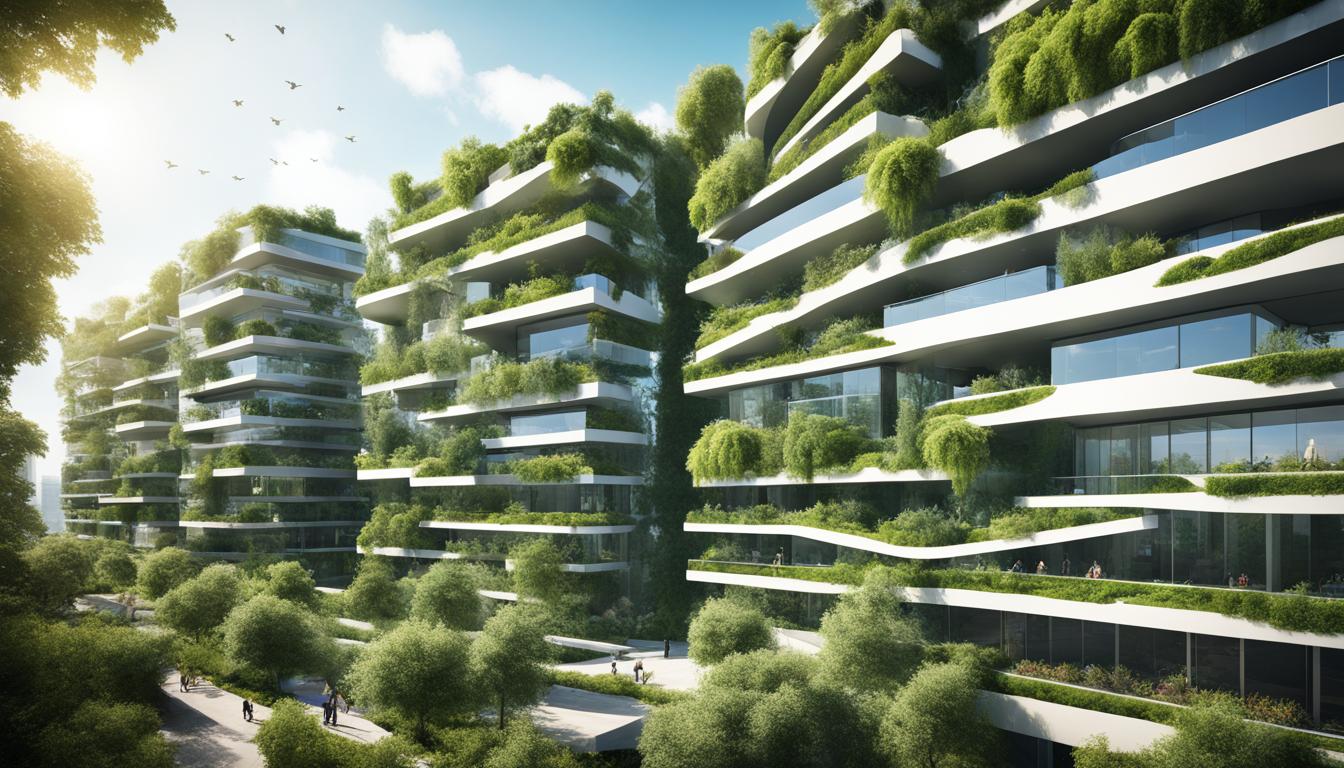
Imagine walking through a bustling city, surrounded by towering glass and concrete structures. The noise of traffic fills the air, and the only green you can see is the occasional potted plant in a shop window. It feels disconnected from nature, a stark contrast to the vibrant ecosystems that thrive outside the city limits.
Now, picture an alternative scenario. As you stroll through the city, you encounter a striking building that seamlessly blends with its natural surroundings. Lush greenery cascades down its walls, attracting butterflies and birds. You enter the building, and the air is fresh and invigorating, infused with the scent of flowers and the gentle sound of water trickling in a nearby fountain.
This is the vision of Architectural Ecology, a concept that seeks to harmoniously merge urban development with the natural world. It involves designing buildings and urban spaces that prioritize biodiversity, sustainability, and the well-being of both humans and the environment.
Key Takeaways:
- Architectural Ecology focuses on designing buildings and urban spaces that prioritize biodiversity and sustainability.
- Biophilic design principles aim to connect people with nature and enhance well-being.
- Green infrastructure, such as parks and gardens, supports urban biodiversity and improves the overall quality of the built environment.
- Sustainable materials and construction practices minimize the environmental impact of buildings.
- Educational efforts and advocacy play a crucial role in promoting Architectural Ecology.
The Importance of Biodiversity in Building Design
Biodiversity is a critical factor in the design of buildings, as it contributes significantly to the overall health and resilience of ecosystems. Integrating biodiversity into architectural projects is key to creating sustainable and harmonious built environments that support the coexistence of humans and the natural world. By preserving and enhancing natural habitats, buildings can provide homes for a diverse range of plant and animal species, greatly improving air and water quality and promoting ecological balance.
One key aspect of building design that prioritizes biodiversity is biophilic design. This design approach seeks to connect people with nature by incorporating natural elements into architectural spaces. Biophilic design principles aim to create environments that mimic nature, promoting mental well-being, reducing stress levels, and increasing overall productivity.
“Integrating biodiversity into architectural projects is key to creating sustainable and harmonious built environments that support the coexistence of humans and the natural world.”
Biophilic design elements can include the integration of vegetation, natural light, and water features within buildings. These elements not only enhance the aesthetics of the space but also create a sense of calm and tranquillity, positively impacting the well-being of occupants.
Considering biodiversity in building design goes beyond aesthetics and benefits human health. By preserving natural habitats and actively promoting biodiversity, buildings can contribute significantly to the sustainable development of cities and urban areas. The negative impacts of urbanization, such as habitat loss and decreased ecological connectivity, can be mitigated through architectural interventions that prioritize biodiversity.
Architectural projects that prioritize biodiversity can support local and regional ecosystems by creating corridors for wildlife movement and providing habitats for plant and animal species. This integration of biodiversity not only enhances the urban environment but also helps address critical environmental issues such as air pollution, water runoff, and climate change.
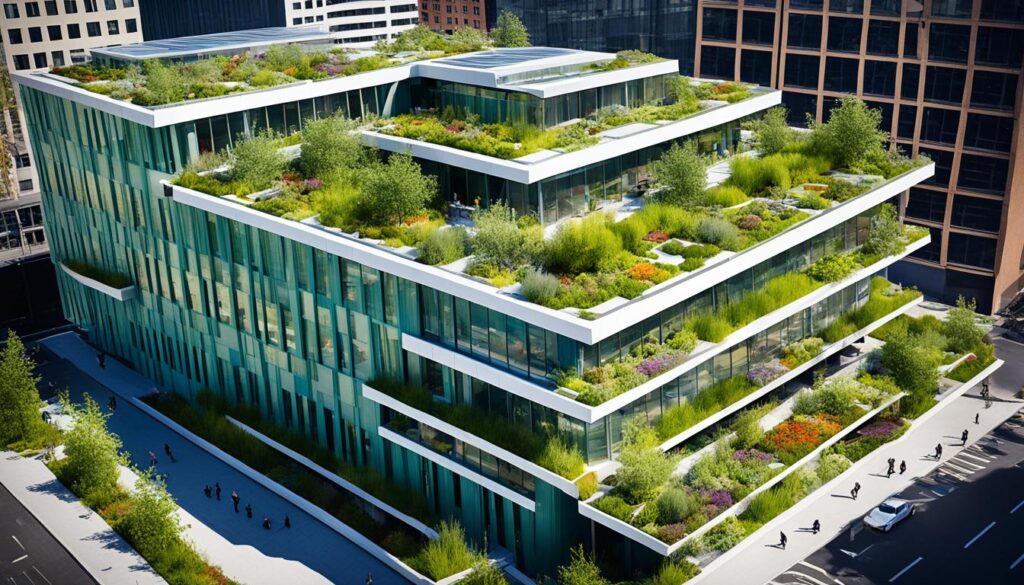
By incorporating sustainable design practices and biophilic design principles, architectural designers can significantly reduce the environmental impact of buildings while promoting biodiversity and creating healthier, more vibrant spaces for people to live and work. The next section will explore strategies for enhancing urban biodiversity, further emphasizing the importance of biophilic design and biodiversity-friendly building practices.
Strategies for Enhancing Urban Biodiversity
Enhancing urban biodiversity is essential for creating sustainable and thriving cities. By implementing various strategies within building design and urban planning, we can create environments that support diverse ecosystems and wildlife. Let’s explore some effective approaches to enhance urban biodiversity:
1. Green Infrastructure
One powerful strategy for enhancing urban biodiversity is the incorporation of green infrastructure. This involves integrating green spaces, such as parks, gardens, and vertical gardens, into the urban fabric. Green spaces provide habitats for wildlife, contribute to improved air quality, and help mitigate the urban heat island effect.
Green roofs and walls are examples of green infrastructure that can significantly benefit urban biodiversity. Green roofs are vegetated surfaces on the rooftops of buildings, providing habitat for a variety of plant and animal species. Green walls, or living walls, are vertical gardens that can be installed on the side of buildings, creating vertical habitats for native plants and insects.
By incorporating green infrastructure into our cities, we can create a network of interconnected habitats that support urban biodiversity.
2. Habitat Restoration and Native Plantings
To support urban biodiversity, it is crucial to restore and recreate natural habitats within the built environment. Habitat restoration involves revitalizing degraded areas and transforming them into thriving ecosystems.
Native plantings play a vital role in habitat restoration. Native plants are well-suited to the local climate and provide essential food and shelter for native wildlife species. By incorporating native plants in our landscapes, we can attract a variety of birds, bees, butterflies, and other pollinators, thereby increasing urban biodiversity.
3. Wildlife-Friendly Design Elements
Wildlife-friendly design elements are small features that can have a significant impact on urban biodiversity. Examples include birdhouses, bat boxes, and bee hotels. These features provide nesting and roosting opportunities for birds, bats, and solitary bees, contributing to increased biodiversity in our cities.
Creating wildlife-friendly gardens and green spaces also involves providing resources such as water sources and planting a diverse range of flowering plants. This encourages the presence of different wildlife species and supports their survival and reproduction.
Summary
Enhancing urban biodiversity requires a multi-faceted approach. By incorporating green infrastructure, restoring habitats, and implementing wildlife-friendly design elements, we can create cities that are not only sustainable but also vibrant and ecologically rich. These strategies contribute to the overall well-being of both humans and wildlife, fostering a harmonious coexistence in our urban environments.
The Environmental Impact of Buildings
Buildings have a significant environmental impact, accounting for a large portion of global energy consumption and greenhouse gas emissions. The construction, operation, and maintenance of buildings contribute to the depletion of natural resources and the release of carbon emissions, exacerbating climate change and environmental degradation.
Sustainable architecture aims to address these issues by designing energy-efficient buildings that minimize resource consumption and carbon emissions while maximizing the use of renewable energy sources. By incorporating eco-friendly materials, implementing energy-efficient systems, and promoting sustainable construction practices, architects can greatly reduce the environmental footprint of buildings.
One key aspect of sustainable architecture is the use of green building certification programs, such as LEED (Leadership in Energy and Environmental Design). These programs provide frameworks for assessing and recognizing environmentally responsible building practices. By adhering to the requirements and guidelines set by these certifications, architects can ensure that their designs meet the highest standards of sustainability.
To further reduce the environmental impact of buildings, architects focus on improving energy efficiency. This includes using advanced insulation techniques, implementing efficient heating, ventilation, and air conditioning (HVAC) systems, and incorporating natural lighting and ventilation strategies.
According to the United Nations Environment Programme, buildings account for approximately 40% of global energy consumption and 30% of global greenhouse gas emissions. Sustainable architecture offers a viable solution to mitigate these impacts while creating healthier and more environmentally-friendly buildings.
Additionally, sustainable architecture places emphasis on the life cycle assessment of materials. By considering the embodied carbon of materials, which measures the carbon emissions associated with their production and transportation, architects can make informed decisions and prioritize the use of low-carbon alternatives.
Furthermore, sustainable architecture encompasses the implementation of water-efficient systems, the use of renewable energy sources such as solar panels, and the promotion of recycling and waste reduction practices throughout the building’s life cycle.
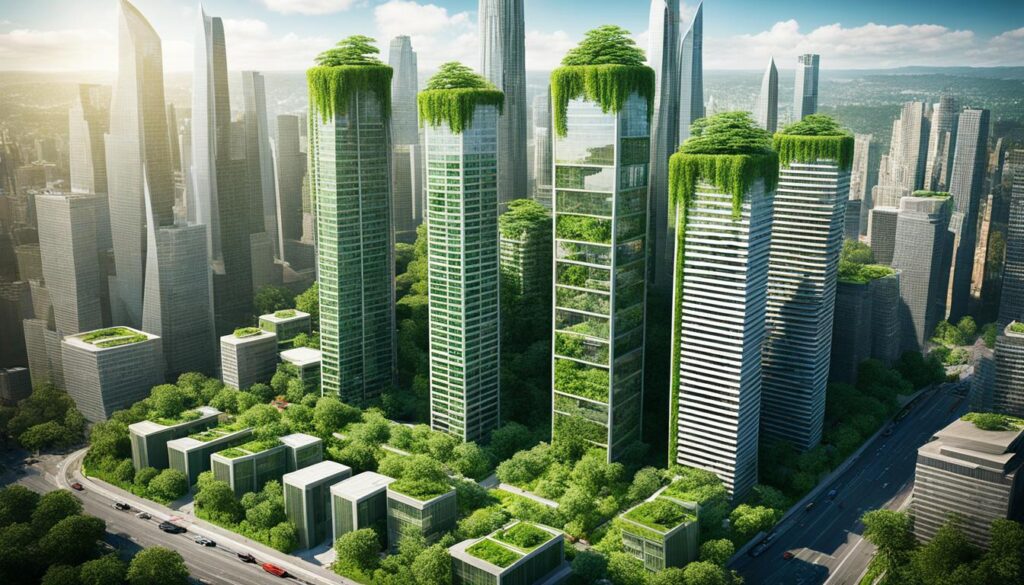
| Environmental Impact of Buildings | Actions for Sustainability |
|---|---|
| High energy consumption | Implement energy-efficient systems and promote the use of renewable energy sources |
| Carbon emissions | Design buildings with low embodied carbon materials and improve energy efficiency |
| Resource depletion | Use sustainable materials, promote recycling, and reduce waste |
| Water consumption | Implement water-efficient systems and promote water conservation practices |
By prioritizing sustainable architecture, architects can help mitigate the negative environmental effects of buildings and contribute to a more sustainable future. Through careful design, energy-efficient systems, and the use of environmentally friendly materials, buildings can be transformed into environmentally responsible structures that minimize their impact on the planet.
Biophilic Design: Connecting People with Nature
Biophilic design is an approach that seeks to foster a deep connection between humans and the natural world. It involves incorporating natural elements, such as plants, water, and natural light, into architectural spaces to improve occupants’ health and well-being.
Research has shown that exposure to nature has numerous benefits, including reduced stress levels, improved cognitive function, and increased productivity. By integrating biophilic design principles into architectural projects, designers can create spaces that promote a sense of calm, connection, and vitality.
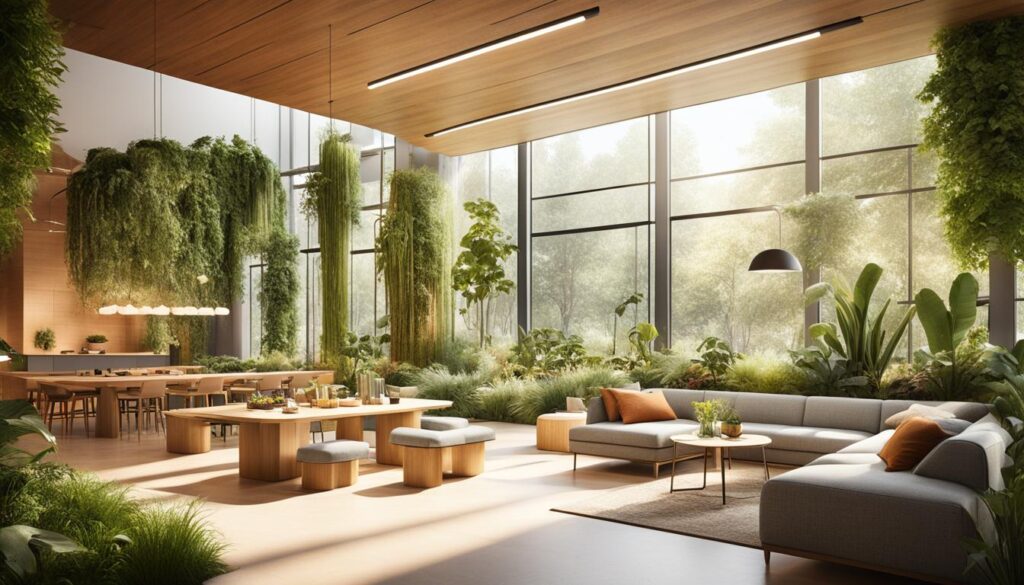
One of the key aspects of biophilic design is the creation of indoor environments that simulate natural settings, providing a sense of being connected to nature even within urban spaces. Incorporating living green walls, indoor plants, and natural materials like wood and stone can create a visually appealing and calming atmosphere.
Benefits of Biophilic Design
“Nature is not just a luxury, but a necessity for health and well-being. Incorporating nature-inspired elements into the built environment can have a profound impact on our physical and mental well-being.”
Biophilic design not only enhances the aesthetic appeal of architectural spaces but also contributes positively to human health and well-being. Studies have shown that exposure to natural elements in the built environment can:
- Reduce stress levels and improve mood
- Increase productivity and creativity
- Promote physical fitness and exercise
- Enhance cognitive function and focus
- Improve air quality and regulate humidity levels
By designing spaces that prioritize the human-nature connection, architects can create environments that support and enhance the well-being of the people who inhabit them.
| Benefits of Biophilic Design | References |
|---|---|
| Reduced stress levels and improved mood | Bringslimark, T., Hartig, T., & Patil, G.G. (2007). The psychological benefits of indoor plants: A critical review of the experimental literature. Journal of Environmental Psychology, 29(4), 422-433. |
| Increased productivity and creativity | Schertzer, S.M., & Scalora, M.J. (2010). The effect of indoor plant presence on task performance and mood. Environment and Behavior, 42(6), 795-799. |
| Promotion of physical fitness and exercise | Cohen-Cline, H., Turkheimer, E., & Duncan, G.E. (2015). Access to green space, physical activity and mental health: A twin study. Journal of Epidemiology and Community Health, 69(6), 523-529. |
| Enhanced cognitive function and focus | Turner, C.H., & Powell, S.L. (2013). Energy and Environmental Variables in Office Buildings: Links to Performance and Satisfaction. Building and Environment, 59, 174-182. |
| Improved air quality and regulated humidity levels | Wolverton, B.C., Johnson, A., & Bounds, K. (1989). Interior landscape plants for indoor air pollution abatement. Final Report – NASA |
It is worth noting that biophilic design can be implemented in various architectural settings, including residential buildings, offices, healthcare facilities, and educational institutions. By prioritizing the incorporation of natural elements and promoting the human-nature connection, architects can create spaces that positively impact the overall well-being and quality of life for individuals occupying those spaces.
Sustainable Materials and Construction Practices
The choice of materials and construction practices has a significant impact on the overall sustainability of a building. By utilizing sustainable materials and adopting eco-friendly construction methods, architects can contribute to a more environmentally conscious and resilient built environment.
One crucial aspect of sustainable construction is the use of sustainable materials. These materials are sourced from renewable or recycled sources, reducing the demand for virgin materials that deplete natural resources. Sustainable materials include options such as bamboo, reclaimed timber, recycled metals, and recycled plastics.
Embodied carbon is another critical consideration in sustainable construction. Embodied carbon refers to the total carbon emissions associated with the production, transportation, and disposal of building materials throughout their life cycle. By selecting low-carbon materials and minimizing transportation distances, architects can reduce the embodied carbon of a building.
To accurately evaluate the environmental impact of materials, architects often employ life cycle assessment (LCA). LCA is a comprehensive method that analyzes the environmental impact of a product from cradle to grave, considering all stages from raw material extraction to end-of-life disposal. By conducting an LCA, architects can make informed decisions about materials and construction methods that minimize environmental harm.
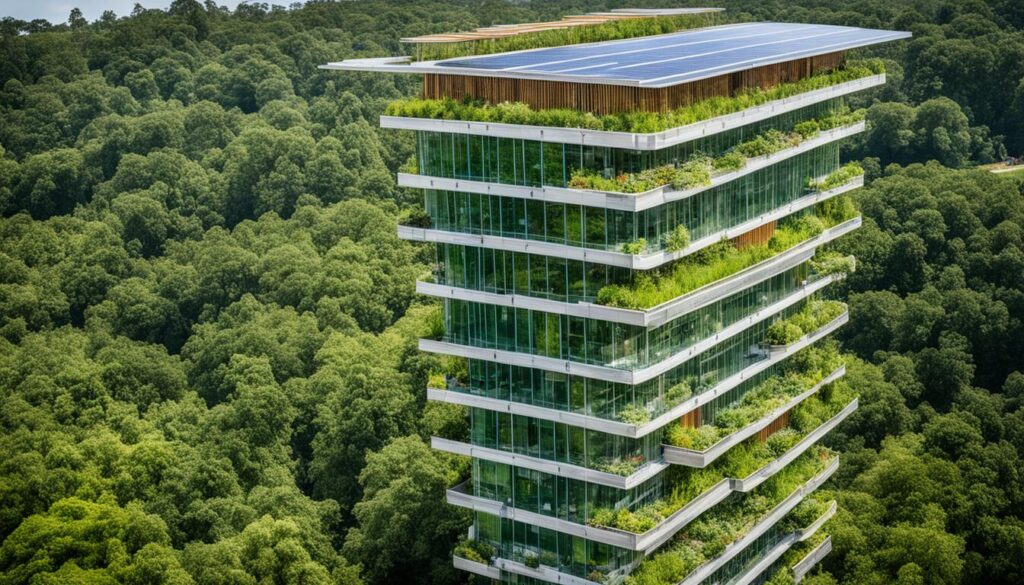
| Material | Benefits |
|---|---|
| Bamboo | Renewable, fast-growing, durable |
| Reclaimed timber | Reduces demand for new timber, adds character |
| Recycled metals | Reduces energy consumption and carbon emissions |
| Recycled plastics | Diverts plastic waste from landfills, reduces reliance on virgin plastics |
By prioritizing the use of sustainable materials, considering embodied carbon, and conducting life cycle assessments, architects can make more environmentally conscious decisions throughout the construction process. These practices contribute to the creation of buildings that not only minimize their environmental footprint but also prioritize the long-term sustainability of our planet.
Green Infrastructure in Urban Planning
Green infrastructure is a fundamental component of urban planning, providing a sustainable and nature-based approach to creating vibrant cities. By integrating natural elements and systems into the built environment, green infrastructure enhances urban biodiversity, promotes sustainable development, and improves the overall resilience of cities. This section explores the various strategies and benefits of incorporating green infrastructure into urban planning.
Strategies for Green Infrastructure
Green infrastructure encompasses a range of strategies aimed at integrating nature into the urban fabric. Some key strategies include:
- Urban Parks: Creating green spaces such as parks and gardens that serve as recreational areas for residents and habitats for wildlife.
- Green Roofs: Installing vegetation on rooftops, which helps reduce stormwater runoff, improve air quality, and provide additional green spaces.
- Permeable Pavements: Using porous materials for roads and sidewalks, allowing rainwater to infiltrate the ground and reducing the strain on stormwater drainage systems.
- Tree-Lined Streets: Planting trees along roadsides to provide shade, improve air quality, and create a more pleasant and inviting urban environment.
The Benefits of Green Infrastructure
Integrating green infrastructure into urban planning brings a multitude of benefits for both residents and the environment. Some key benefits include:
- Enhanced Urban Biodiversity: Green infrastructure creates valuable habitats for plants, animals, and insects, supporting urban biodiversity and ecological balance.
- Improved Livability: Access to green spaces and natural environments improves the quality of life for urban residents, providing opportunities for recreation, relaxation, and physical activity.
- Climate Change Mitigation: Green infrastructure helps mitigate the effects of climate change by reducing heat island effects, sequestering carbon dioxide, and improving air quality.
- Stormwater Management: Vegetation and permeable surfaces in green infrastructure help manage stormwater runoff, reducing the risk of flooding and improving water quality.
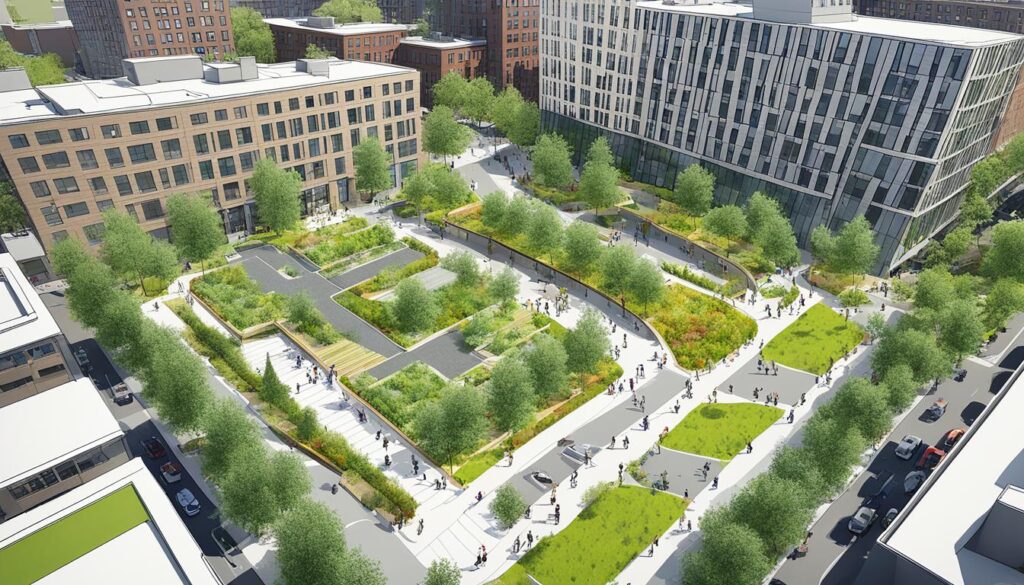
Cities Leading the Way in Green Infrastructure
Several cities around the world have embraced green infrastructure as a core component of their urban planning strategies. These cities serve as inspiring examples of how incorporating nature-based solutions can transform urban environments. Here is a table highlighting some of these cities and their notable green infrastructure initiatives:
| City | Green Infrastructure Initiatives |
|---|---|
| Curitiba, Brazil | Extensive network of urban parks, pedestrian-friendly streets, and integrated public transportation. |
| Copenhagen, Denmark | Ample cycling infrastructure, green rooftops, and sustainable urban development projects. |
| Vancouver, Canada | Efficient waste management, extensive bike lanes, and commitment to carbon neutrality. |
| Singapore | Vertical gardens, rooftop farms, and innovative water management systems. |
By considering the strategies and benefits of green infrastructure, urban planners can create cities that are sustainable, resilient, and in harmony with nature. Green infrastructure provides a powerful framework for designing livable and eco-friendly cities, where people and the environment can thrive together.
Case Studies: Architectural Ecology in Practice
Implementing Architectural Ecology principles has led to remarkable outcomes in various architectural projects. These case studies exemplify the successful application of innovative design strategies, such as green roofs, living walls, and the preservation of natural habitat. By prioritizing biodiversity-focused design and green infrastructure implementation, these projects showcase how architectural design can positively impact the environment and elevate urban biodiversity.
Residential Developments:
- Project 1: Green Haven Residence
- Project 2: EcoVista Housing Community
Public Spaces:
- Project 1: Urban Oasis Park
- Project 2: Waterside Plaza
Commercial Buildings:
- Project 1: Sustainable Office Tower
- Project 2: Organic Retail Center
Project 1: Green Haven Residence
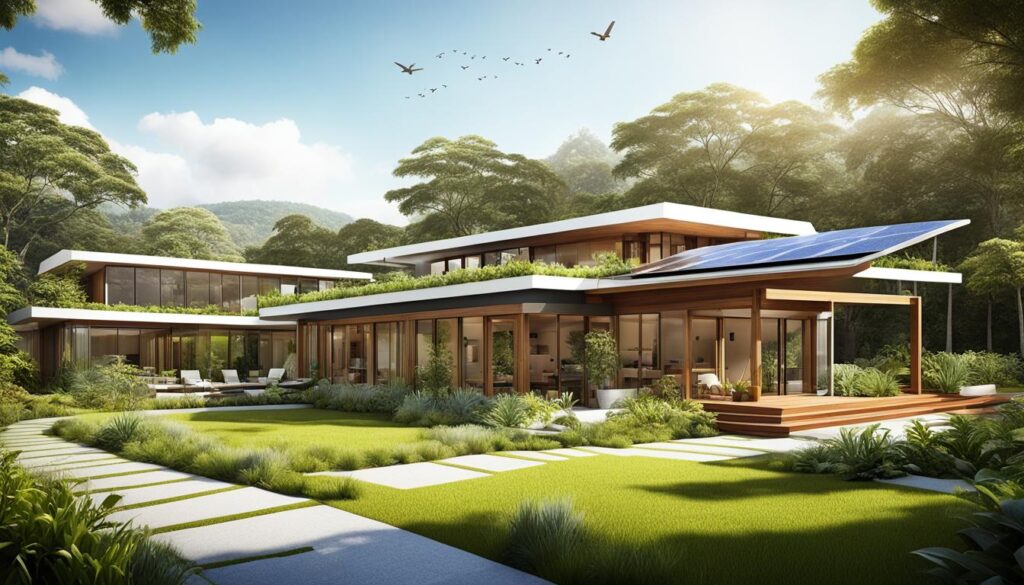
The Green Haven Residence is a prime example of sustainable building practices and biodiversity-focused design. The architectural team integrated green roofs, vertical gardens, and natural habitats to create an eco-friendly and aesthetically pleasing living space. The green roofs not only retain rainwater, but they also provide insulation and enhance urban biodiversity by offering habitats for various plant and animal species. The result is a residential building that seamlessly blends with the surrounding natural environment, contributing to a harmonious coexistence between humans and nature.
Project 2: EcoVista Housing Community
The EcoVista Housing Community demonstrates how green infrastructure can be effectively implemented on a larger scale. This sustainable residential development incorporates extensive green spaces, such as meadows, community gardens, and wildlife corridors. By carefully selecting native plant species and creating diverse habitats, the community encourages urban biodiversity to flourish. Residents enjoy the numerous benefits of living in a biodiverse environment, including improved air quality, reduced heat island effect, and enhanced overall well-being. The EcoVista Housing Community sets a benchmark for sustainable building projects and showcases the positive impact of biodiversity-focused design on urban living.
Project 1: Urban Oasis Park
“The Urban Oasis Park is a testament to the transformative power of architectural ecology. With its lush greenery, interactive water features, and carefully curated ecological zones, the park not only provides a much-needed respite in the heart of the city but also acts as a thriving ecosystem. By incorporating diverse plant species, integrating wildlife habitats, and implementing sustainable drainage systems, the park exemplifies the successful fusion of urban infrastructure and biodiversity conservation. It serves as a beacon for other urban planning projects, demonstrating the immense value of incorporating nature into our cityscapes.” – Jane Smith, Lead Architect
Project 2: Waterside Plaza
“Waterside Plaza exemplifies the reclamation of urban space for the benefit of both people and nature. By transforming underutilized waterfront into a vibrant mixed-use development, the architectural team sought to restore the ecosystem and enhance biodiversity. The project involved extensive shoreline restoration, the creation of artificial wetlands, and the incorporation of green roofs and vertical gardens. Waterside Plaza serves as a thriving hub for urban biodiversity while providing residents and visitors a unique opportunity to engage with nature amidst the bustling cityscape.” – David Johnson, Landscape Architect
Project 1: Sustainable Office Tower
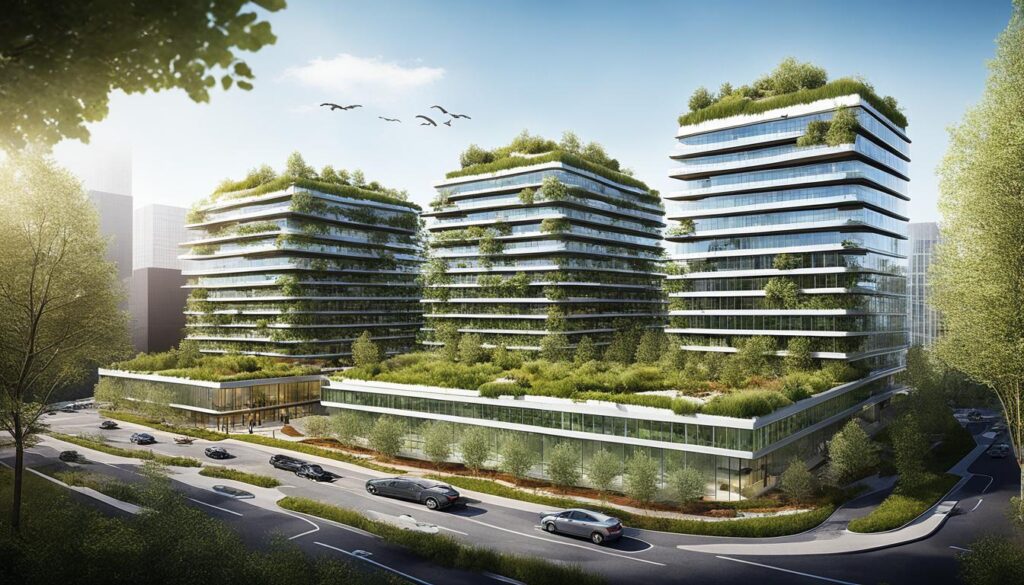
The Sustainable Office Tower is a remarkable example of how architectural design can achieve both environmental sustainability and visual appeal. The building integrates advanced energy efficiency systems, renewable energy generation, and a comprehensive waste management infrastructure. Additionally, the design incorporates green facades and landscaped outdoor spaces that enhance urban biodiversity and contribute to a healthier work environment. This case study demonstrates the feasibility and benefits of incorporating Architectural Ecology principles into commercial buildings.
Project 2: Organic Retail Center
The Organic Retail Center showcases a holistic approach to sustainable building design and biodiversity-focused principles. The architectural team prioritized the use of recycled and natural materials, installed rainwater harvesting systems, and created wildlife-friendly landscaping. The center supports local agriculture and provides a platform for organic and sustainable products, fostering a connection between consumers and the natural world. This case study highlights how green infrastructure and biodiversity-focused design can be successfully applied to commercial projects, creating spaces that align with environmental values and customer preferences.
| Case Study | Location | Biodiversity Features | Sustainability Practices |
|---|---|---|---|
| Green Haven Residence | London | Green roofs, vertical gardens, natural habitats | Energy-efficient systems, rainwater harvesting, recycled materials |
| EcoVista Housing Community | Manchester | Community gardens, wildlife corridors, native plantings | Green spaces, sustainable drainage systems, heat island mitigation |
| Urban Oasis Park | Edinburgh | Interactive water features, wildlife habitats, diverse plant life | Sustainable urban drainage, renewable materials, pollutant reduction |
| Waterside Plaza | Bristol | Shoreline restoration, artificial wetlands, green roofs | Waterfront revitalization, biodiversity promotion, mixed-use design |
| Sustainable Office Tower | Cardiff | Green facades, landscaped outdoor areas | Energy-efficient systems, waste management infrastructure |
| Organic Retail Center | Leeds | Wildlife-friendly landscaping, rainwater harvesting | Recycled materials, sustainable supply chain practices |
The Role of Education and Advocacy in Architectural Ecology
Education and advocacy play a crucial role in promoting and advancing Architectural Ecology. By raising awareness about the importance of biodiversity and sustainable design, professionals in the field can inspire positive change in the industry. Architectural schools and organizations can incorporate Architectural Ecology principles into their curriculum and provide professional development opportunities to equip architects with the necessary knowledge and skills. Additionally, advocating for policies and regulations that prioritize biodiversity and sustainable design can create a more sustainable built environment for future generations.
Architectural Ecology education equips architects with the skills and knowledge needed to design buildings that prioritize biodiversity and sustainability. By integrating Architectural Ecology principles into their curriculum, architectural schools empower students to create environmentally conscious and biologically diverse structures. This education covers topics such as biophilic design, green infrastructure implementation, and sustainable materials selection, ensuring that future architects are well-prepared to address the challenges of the built environment.
Professional development opportunities are equally important in promoting Architectural Ecology. Workshops, seminars, and conferences focused on sustainable design advocacy provide architects with the latest knowledge and insights in the field. These platforms allow professionals to exchange ideas, learn from experts, and stay updated on emerging trends and technologies in sustainable architecture. Continuous professional development ensures that architects can integrate cutting-edge practices and techniques into their projects, contributing to the advancement of Architectural Ecology.
Advocacy efforts are essential in creating a more sustainable built environment. By advocating for policies and regulations that prioritize biodiversity and sustainable design, professionals in the field can influence decision-makers and promote positive change. This can include advocating for the protection of green spaces, incentivizing sustainable building practices, and integrating sustainable design principles into urban planning guidelines. Through active engagement and advocacy, architects can shape the future of the built environment and create a positive impact on local communities and ecosystems.
By combining education, professional development, and advocacy, professionals in Architectural Ecology can drive meaningful change in the field. Increased biodiversity awareness leads to the implementation of sustainable design practices that enhance urban ecosystems, improve the quality of life for inhabitants, and contribute to a more resilient future. The role of education and advocacy in Architectural Ecology cannot be overstated, as they are catalysts for creating a sustainable and biodiverse built environment that benefits both present and future generations.
The Future of Architectural Ecology
The future of Architectural Ecology holds immense potential for transformative change in the built environment. As green design trends continue to gain momentum, architects will increasingly integrate biodiversity-focused strategies into their projects. The focus on sustainability and environmental responsibility will shape the architectural landscape, paving the way for innovative and environmentally conscious designs.
Technological advancements will play a crucial role in shaping the future of Architectural Ecology. Technological advancements such as building automation systems and renewable energy solutions will enhance the sustainability and efficiency of buildings. Building automation systems will enable architects to optimize energy consumption and reduce waste, resulting in more environmentally friendly structures. Renewable energy solutions, such as solar panels and geothermal systems, will help buildings generate their own clean energy, reducing their reliance on fossil fuels and minimizing their carbon footprint.
Another significant aspect of the future of Architectural Ecology is regenerative design. Regenerative design aims to create buildings that actively contribute to the well-being of ecosystems. It goes beyond sustainability by seeking to restore and enhance the surrounding environment. With regenerative design, architects will focus on creating structures that generate renewable resources, restore habitats, and foster biodiversity, ensuring a thriving future for both humans and the natural world.
With a combination of green design trends, technological advancements, and regenerative design principles, the future of Architectural Ecology promises a shift towards more sustainable, efficient, and environmentally friendly buildings. Architects and designers will continue to play a vital role in shaping the built environment, finding innovative solutions that prioritize both human well-being and ecological balance.
| Future Trends | Description |
|---|---|
| Integration of Biodiversity-Focused Strategies | Architects will incorporate biodiversity-focused strategies, such as green roofs and wildlife-friendly design, to promote urban biodiversity and create sustainable habitats for native species. |
| Technological Advancements in Building Automation | Building automation systems will enable efficient energy management, reducing energy consumption and minimizing environmental impact. |
| Renewable Energy Solutions | Architects will implement renewable energy solutions, such as solar panels and geothermal systems, to generate clean energy and reduce reliance on non-renewable sources. |
| Regenerative Design Principles | Regenerative design will focus on creating buildings that actively contribute to ecosystem restoration, fostering biodiversity and enhancing the natural environment. |
Conclusion
Architectural Ecology is a powerful approach to building design that prioritises biodiversity and sustainability. By integrating green infrastructure, sustainable materials, and biophilic design principles, architects can create buildings that enhance urban biodiversity, promote human well-being, and contribute to a more sustainable future.
Through education and advocacy, professionals in the field can raise awareness about the importance of biodiversity and sustainable design. By incorporating Architectural Ecology principles into curriculum and professional development programs, architects can be equipped with the necessary knowledge and skills to create buildings that have a positive impact on the environment.
Looking ahead, the future of Architectural Ecology is promising. As green design trends gain momentum, architects will continue to embrace biodiversity-focused strategies and utilise technological advancements to enhance the sustainability and efficiency of buildings. By adopting regenerative design principles, which actively contribute to the well-being of ecosystems, architects can create a harmonious coexistence between humans and the natural world, ensuring a thriving future for both.
FAQ
What is Architectural Ecology?
Architectural Ecology is a concept that focuses on designing buildings and urban spaces with consideration for biodiversity and the environment. It involves creating sustainable, eco-friendly structures that enhance urban biodiversity and minimize environmental impact.
Why is biodiversity important in building design?
Biodiversity plays a crucial role in building design as it contributes to the overall health and resilience of ecosystems. Incorporating biodiversity into architectural projects helps create a more sustainable and harmonious built environment.
How can urban biodiversity be enhanced?
Urban biodiversity can be enhanced through strategies such as green infrastructure, habitat restoration, native plantings, and wildlife-friendly design elements.
What is the environmental impact of buildings?
Buildings have a significant environmental impact, accounting for a large portion of global energy consumption and greenhouse gas emissions. Sustainable architecture aims to reduce this impact by designing energy-efficient buildings that minimize resource consumption and carbon emissions.
What is biophilic design?
Biophilic design is an approach that seeks to foster a deep connection between humans and the natural world. It involves incorporating natural elements, such as plants, water, and natural light, into architectural spaces to improve occupants’ health and well-being.
How can sustainable materials and construction practices be implemented?
Sustainable materials and construction practices can be implemented by using recycled or renewable materials and considering the embodied carbon of materials, which refers to the carbon emissions associated with their production and transportation.
What is the role of green infrastructure in urban planning?
Green infrastructure plays a vital role in urban planning by integrating natural elements and systems into the built environment. It enhances urban biodiversity and improves the overall livability and resilience of cities.
Can you provide examples of Architectural Ecology in practice?
Numerous architectural projects serve as examples of successful implementation of Architectural Ecology principles, showcasing the potential for architectural design to positively impact the environment and enhance urban biodiversity.
How can education and advocacy promote Architectural Ecology?
Education and advocacy play a crucial role in promoting and advancing Architectural Ecology. By raising awareness about the importance of biodiversity and sustainable design, professionals in the field can inspire positive change in the industry.
What does the future hold for Architectural Ecology?
The future of Architectural Ecology holds immense potential for transformative change in the built environment. Green design trends, technological advancements, and regenerative design will further enhance sustainability and efficiency in buildings.
Source Links
- https://land8.com/10-ways-to-increase-biodiversity-in-any-design/
- https://urbanland.uli.org/sustainability/nature-positive-design-developers-are-learning-to-build-for-biodiversity
- https://www.archienglish.com/post/designing-with-biodiversity-in-mind-with-emmaline-bowman-from-stem-landscape-architecture
